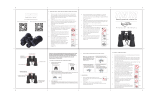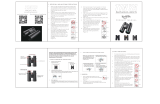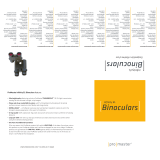
BINOCULAR INSTRUCTIONS
CAUTION: DIRECTLY VIEWING THE SUN OR ANY LIGHT SOURCE
WITH THIS OPTICAL DEVICE CAN CAUSE PERMANENT EYE DAMAGE.
Fig.4 BINOCULAR EYECUPS
Roll Down Eye Cups
BC285
©2015 BARSKA
®
Pomona, CA 91767, USA
www.barska.com
©2015 BARSKA
®
Pomona, CA 91767, USA
www.barska.com
models may vary
III. WATERPROOF/FOG-PROOF (select models)
Your binocular may be designed and built utilizing the
latest waterproof and fog-proof technology.
Waterproof models are O-ring sealed for complete
protection. Fog proof protection is achieved from dry
nitrogen purging to remove all internal moisture.
IV. EYECUPS
Your binocular is fitted with either rubber roll-down
or rubber pop-up eyecups designed for your comfort
and to exclude extraneous external light. If you wear
sun/eye glasses, roll down the eyecups. This will
bring your eyes closer to the binocular lens thus
providing improved field of view.
V. INSTRUCTIONS FOR CARE
If handled with care, this binocular will provide years
of trouble-free service. Like any fine optical
instrument your binocular should be given sensible
care. Non waterproof models should not be exposed
to excessive moisture.
1. Keep the lens covers (that come with your
binocular, except compact models) on the
lenses when binoculars are not in use.
2. Store binoculars with the eyecups up. Thus
avoiding excessive stress and wear on the
eyecups in the down position.
3. Avoid banging and dropping.
4. Store in a cool, dry place.
5. Looking directly at the sun with your binocular
may be very harmful to you eyes.
VI. CLEANING
1. Blow away any dust or debris on the lens (or
use a soft lens brush)
2. To remove dirt or fingerprints, clean with a
soft cotton cloth rubbing in a circular motion.
Use of a coarse cloth or unnecessary rubbing
may scratch the lens surface and eventually
cause permanent damage.
3. For a more thorough cleaning, photographic
lens tissue and photographic-type lens cleaning
fluid or isopropyl alcohol may be used. Always
apply the fluid to the cleaning cloth-never
directly on the lens.
VERY IMPORTANT
Never attempt to clean your binocular internally or try
to take it apart.

2. Cover right objective (front) lens with your
hand. Rotate left eyepiece until image is
focused.
3. Follow the same procedure for the right eye.
The eyepiece should be turned in a counter-
clockwise direction for more distant objects.
With the image now in focus, make a note of
the diopter setting for future use.
FOCUS-FREE (select models)
Focus-free binoculars offer “never needs focusing”
optical systems.
“ZOOM” FEATURE (select models)
1. Follow the steps for focusing as outlined under
“Center Focus”
2. When focusing a “zoom” binocular, it is best to
begin at the highest power. This will provide a
more comfortable focus at the lower powers.
Set the “zoom” lever at high power.
3. Adjust your binocular for individual eye
strength using the “diopter setting”
Your binocular is now adjusted properly for your
eyes. You may now “zoom” “out” or “in” on any
distant object.
Note: to focus on an object at a closer distance,
focus on the object at high power first and then adjust
the “zoom” lever to the desired lower power. With any
“zoom” instrument, better quality images are possible
at lower powers.
CENTER FOCUS-has a central focusing wheel
between the barrels.
INDIVIDUAL FOCUS-each eyepiece is focused
separately. Most typically with waterproof/fog-proof
models.
FOCUS FREE-binocular require no focusing
adjustment.
CENTER FOCUS
1. Adjust interpupillary distance (Figure 1)
2. Keep both eyes “open” at all times.
3. Using a lens cover or your hand, cover the
objective (front) lens of the side with the
“diopter setting”
4. Using the center focus wheel, focus the
distant object being viewed.
5. Cover the other objective lens, then view
the same object as explained above.
6. Using the “diopter setting” adjustment ring,
focus the same object being viewed. Caution
should be used as over turning or forcing the
diopter eyepiece can damage or cause the
eyepiece to break away from the chassis.
7. Your binocular should be adjusted for your
eyes. Focus at both far and near distance can
now be attained simply by turning the center
focus wheel.
INDIVIDUAL FOCUS (select models)
1. Adjust interpupillary distance. Make a note of
the number which appears on the central
hinge scale. Always re-set your binocular to
this position before using. (To see a single
circular field.)
INSTRUCTIONS FOR USE
This binocular is a precision instrument designed to
provide many years of pleasurable viewing. This
booklet will help you achieve optimum performance
by explaining how you can adjust the binocular to
your eyes, and how to care for this instrument. Read
the instructions carefully before using your
binoculars.
I. EYE ADJUSTMENTS (FIGURE 1)
HOW TO ADJUST FOR DISTANCE BETWEEN
YOUR EYES
The distance between the eyes, called “interpupillary
distance” (IPD), varies from person to person. To
achieve perfect alignment of lens to eye, follow these
simples steps.
1. Hold your binocular in the normal viewing
position.
2. Grasp each barrel firmly. Move the barrels
closer together or further apart until you see a
single circular field. Always re-set your
binocular to this position before using.
HOW TO ADJUST FOR INDIVIDUAL EYE
STRENGTH
Human eyes are as individual as fingerprints. This
binocular has a feature which allows you to adjust the
binocular to your vision. Follow the focusing
instructions for your binocular style.
II. FOCUSING
Binoculars have three primary focusing systems,
center, individual and focus-free. “Zoom” binoculars
utilize the center focus system.
Fig.1 INTERPUPILLARY DISTANCE ADJUSTMENT
Center
Focus
Wheel
Diopter Setting
Fig.2 DIOPTER SETTINGS
Center Focus
Wheel
CAUTION: DIRECTLY VIEWING THE SUN OR ANY LIGHT SOURCE
WITH THIS OPTICAL DEVICE CAN CAUSE PERMANENT EYE DAMAGE.
Zoom Lever
Fig.2 “ZOOM” SETTINGS
-
 1
1
-
 2
2
Barska BINOCULAR User manual
- Category
- Binoculars
- Type
- User manual
Ask a question and I''ll find the answer in the document
Finding information in a document is now easier with AI
Related papers
-
Barska AB10768 User guide
-
Barska AB12802 Owner's manual
-
Barska AB12290 Owner's manual
-
Barska Binoculars AC10552 User manual
-
Barska Optics Catalog 2021 Owner's manual
-
Barska AD12806 Owner's manual
-
Barska AD12756 Operating instructions
-
Barska AH11410 Owner's manual
-
Barska BQ13374 Owner's manual
-
Barska AX13494 Owner's manual
Other documents
-
Hawke Nature trek Top Hinge User manual
-
West Marine Maui 7X42 Owner's manual
-
West Marine Maui 7X42 Owner's manual
-
West Marine 2677631 Owner's manual
-
West Marine 2677680 Owner's manual
-
 Kissarex Adults Compact Travel Binoculars: 8x21&10x25&10x42&12x50 Mini Small Size Lightweight Best Outdoor Theatre Tactical Hiking Kids Concert Sports Camping Low-Light Night Vision Waterproof User manual
Kissarex Adults Compact Travel Binoculars: 8x21&10x25&10x42&12x50 Mini Small Size Lightweight Best Outdoor Theatre Tactical Hiking Kids Concert Sports Camping Low-Light Night Vision Waterproof User manual
-
 Kissarex Adults Compact Travel Binoculars: 8x21&10x25&10x42&12x50 Mini Small Size Lightweight Best Outdoor Theatre Tactical Hiking Kids Concert Sports Camping Low-Light Night Vision Waterproof User manual
Kissarex Adults Compact Travel Binoculars: 8x21&10x25&10x42&12x50 Mini Small Size Lightweight Best Outdoor Theatre Tactical Hiking Kids Concert Sports Camping Low-Light Night Vision Waterproof User manual
-
 Promaster EL High Definition Binoculars 10x42 Owner's manual
Promaster EL High Definition Binoculars 10x42 Owner's manual
-
Yukon 22038 User manual
-
Tasco Sierra TS1025B User manual




